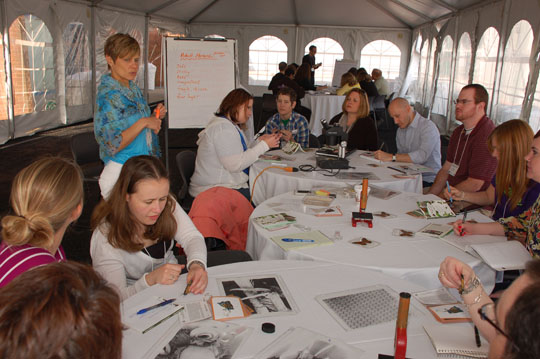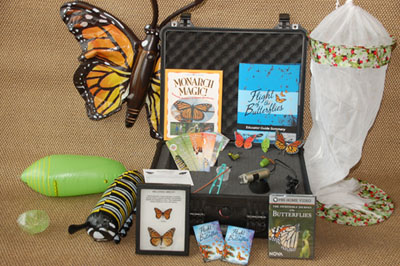Flight of the Butterflies
Flight of the Butterflies was released as an IMAX film in October 2012 and, as of summer 2013, has shown in 125 theaters worldwide for nearly two million viewers. The project was made possible thanks to NSF grant DRL-1027588, which helped fund film production, science advisory input, educational outreach development and project evaluation. SK Films of Toronto oversaw film production with additional support from funding sources in Mexico. Filming took place in Canada, Mexico, the U.S., and the UK. A science advisory team of world-renowned monarch butterfly research scientists and educators provided significant expertise to the project, including Dr. Karen Oberhauser, named a “Champion of Change” by President Obama in June 2013 for her monarch citizen science work, and Dr. Chip Taylor, founder of Monarch Watch at the University of Kansas. The film deals with the unique four-stage life cycle of the monarch, its remarkable navigation and migration, how hundreds of millions of monarchs migrate thousands of miles each year to precise locations where they have never been, and how Dr. Fred and Nora Urquhart discovered the overwintering sites after decades of searching. The film highlights the efforts of citizen scientists who made the migration discovery possible. The Maryland Science Center (MSC) education/outreach team sought to provide theaters playing the film with fundamental materials typically accompanying IMAX films and additionally, to offer unique elements to make the film, its content, and the potential for learning even stronger. Standard elements include an Educator Guide, providing background on the film with a CD of educational activities; four posters covering various aspects of the monarch; and the project website: Flight of the Butterflies. Developed by SK Films, the site describes the film, lists theaters where it plays, gives background information on monarchs and the discovery of their migration, provides educational materials, and lists project partners and sponsors. One unique element of the education effort was an Informal Science Educator Workshop, a two-day, expenses-paid workshop at MSC, introducing museum educators to the monarch butterfly, including hands-on experiences with all stages of its life cycle and demonstrations of activities suitable for use with museum visitors. Forty-seven educators and theater representatives from across North America participated in the workshop. 
Each workshop participant is eligible for a $1,500 mini-grant to develop monarch-related programming at their museums. Programs at participating institutions include an indoor butterfly habitat for monarchs, partnerships with local conservatories, professional development workshops for educators, butterfly gardens adjacent to museums as monarch way stations, monarch tagging activities where visitors catch and tag butterflies, “monarch trees” for visitors to attach hand-made origami butterflies, and workshops making cultural connections between monarch migration and the Mexican Dia de los Muertos. Additional educator workshops and web seminars offer monarch-related content for classroom teachers across the US, held at MSC and during National Science Teachers Association (NSTA) regional and national conferences. To date, 711 educators, informal and formal, have participated in project workshops or webinars. Evaluations revealed extremely positive results with one participant describing the workshop as “the best I have ever attended.” The MSC outreach team also developed sets of exhibit banners and "Traveling Trunks" for theaters and museums, providing no-cost, ready-made materials that are easy to use and display during the film’s run and then return for refurbishment and use at other theaters. Five retractable banners include various aspects of the monarch and citizen science efforts; the banners can be displayed as a set or in smaller groupings, making them usable by differently sized venues. Traveling Trunks, designed for use in museum programs, contain monarch-related activities and supplies: a digital microscope; mounted slides of monarch scales, antennae and compound eye; a butterfly farm rearing kit; a pop-up tent with butterfly netting; and life cycle cards displaying monarch images and facts. More information about the educational materials are available on the project website. 
MSC contracted with RMC Research to conduct project evaluation, asking which film scenes and images were most memorable, what viewers learned about monarchs, how they saw the Urquharts’ scientific quest and their tagging program, how they would describe the work of “citizen scientists,” and if they could imagine doing the work of a citizen scientist. Film viewers in the study were enthusiastic, all agreeing that the film was a “good story well done.” Several found it “exhilarating” and emotionally compelling and praised the way the movie wove together scientific information and entertainment. A number of participants said they were impressed by the amount of science the film presented, and all had very positive comments about the film’s visual qualities. The film conveyed considerable information about monarchs, and all viewers expressed amazement at the extent of the monarch’s migration and that it takes multiple generations to complete a full migratory cycle. The film increased viewer’s science content knowledge: “This changed my understanding of migration,” reported one student who has read books about butterflies independently. All participants found the idea of science as something non-specialists could participate in as intriguing, both engaging citizens in tagging and the idea of contributing to a larger purpose. Some participants had questions they felt the film left unanswered, concerning the timeline of the butterfly generations, their migration patterns, and why monarchs congregated at one place in Mexico. A small number of adults wondered how well the monarch phenomenon was known to Mexican scientists. Participants questioned why the tagging process did not harm the butterflies’ wings, wondered how butterflies fly in the rain, and what triggers the “super” generation (no one knows for sure). Several participants said they would like to see the film a second time, and another reported enjoying leaving a movie with more questions than they came in with, the film serving to spur further learning. Overall, the film increased viewers’ science knowledge, and also raised awareness of the value of citizen participation in science. Evaluation is currently underway on the educational components and will be completed in fall 2013.